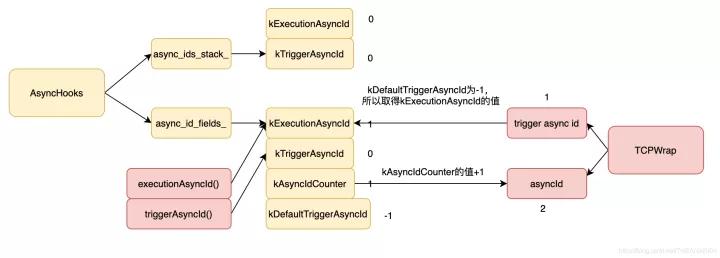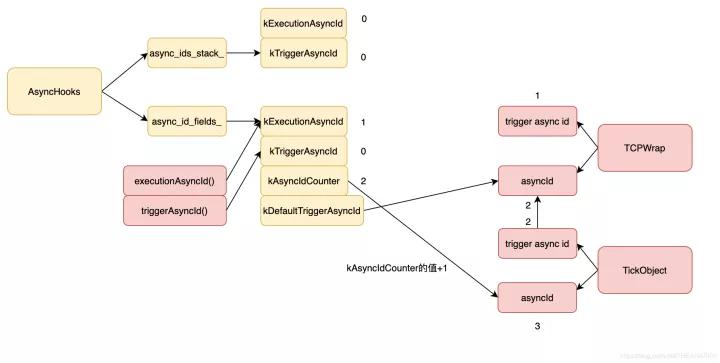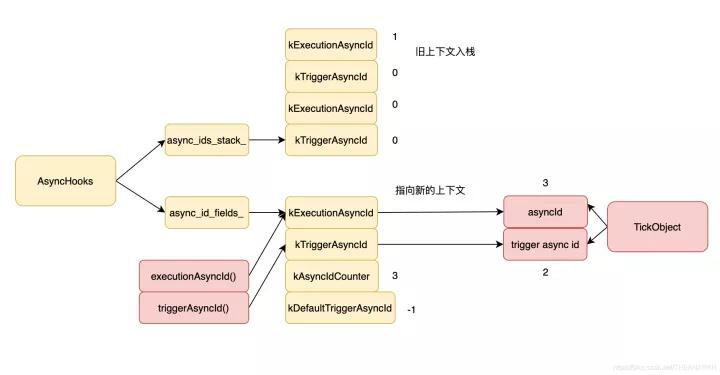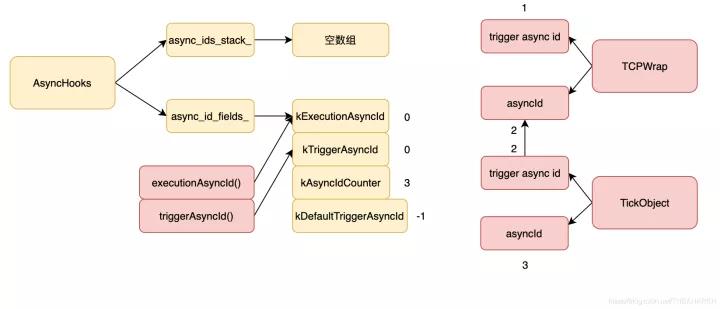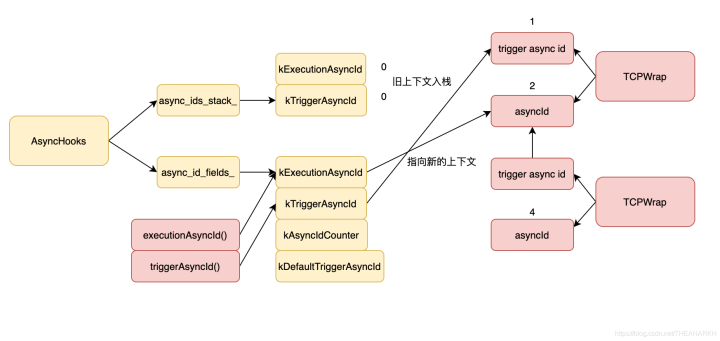虽然Async hooks至此还是实验性API,但是他的确可以解决应用中的一些问题,比如日志和调用栈跟踪。本文从应用和原理方便介绍一下Node.js的Async hooks。
1 env中的AsyncHooks
在Node.js的env对象中有一个AsyncHooks对象,负责Node.js进程中async_hooks的管理。我们看一下定义。
1.1 类定义
- class AsyncHooks : public MemoryRetainer {
- public:
- enum Fields {
- // 五种钩子
- kInit,
- kBefore,
- kAfter,
- kDestroy,
- kPromiseResolve,
- // 钩子总数
- kTotals,
- // async_hooks开启的个数
- kCheck,
- // 记录栈的top指针
- kStackLength,
- // 数组大小
- kFieldsCount,
- };
- enum UidFields {
- kExecutionAsyncId,
- kTriggerAsyncId,
- // 当前async id的值
- kAsyncIdCounter,
- kDefaultTriggerAsyncId,
- kUidFieldsCount,
- };
- private:
- inline AsyncHooks();
- // 异步资源的类型
- std::array<v8::Eternal<v8::String>, AsyncWrap::PROVIDERS_LENGTH> providers_;
- // 栈
- AliasedFloat64Array async_ids_stack_;
- // 整形数组,每个元素值的意义和Fields对应
- AliasedUint32Array fields_;
- // 整形数组,每个元素值的意义和UidFields对应
- AliasedFloat64Array async_id_fields_;
- };
结构图如下
接下来看一下env的AsyncHooks对象提供了哪些API,这些API是上层的基础。
1.2 读API
我们看一下env对象中获取AsyncHooks对象对应字段的API。
- // 获取对应的字段
- inline AliasedUint32Array& AsyncHooks::fields() {
- return fields_;
- }
- inline AliasedFloat64Array& AsyncHooks::async_id_fields() {
- return async_id_fields_;
- }
- inline AliasedFloat64Array& AsyncHooks::async_ids_stack() {
- return async_ids_stack_;
- }
- // 获取资源类型
- inline v8::Local<v8::String> AsyncHooks::provider_string(int idx) {
- return providers_[idx].Get(env()->isolate());
- }
- // 新建资源的时候,获取新的async id
- inline double Environment::new_async_id() {
- async_hooks()->async_id_fields()[AsyncHooks::kAsyncIdCounter] += 1;
- return async_hooks()->async_id_fields()[AsyncHooks::kAsyncIdCounter];
- }
- // 获取当前async id
- inline double Environment::execution_async_id() {
- return async_hooks()->async_id_fields()[AsyncHooks::kExecutionAsyncId];
- }
- // 获取当前trigger async id
- inline double Environment::trigger_async_id() {
- return async_hooks()->async_id_fields()[AsyncHooks::kTriggerAsyncId];
- }
- // 获取默认的trigger async id,如果没有设置,则获取当前的async id
- inline double Environment::get_default_trigger_async_id() {
- double default_trigger_async_id = async_hooks()->async_id_fields()[AsyncHooks::kDefaultTriggerAsyncId];
- // If defaultTriggerAsyncId isn't set, use the executionAsyncId
- if (default_trigger_async_id < 0)
- default_trigger_async_id = execution_async_id();
- return default_trigger_async_id;
- }
1.3 写API
- inline void AsyncHooks::push_async_ids(double async_id,
- double trigger_async_id) {
- // 获取当前栈顶指针
- uint32_t offset = fields_[kStackLength];
- // 不够则扩容
- if (offset * 2 >= async_ids_stack_.Length())
- grow_async_ids_stack();
- // 把旧的上下文压栈
- async_ids_stack_[2 * offset] = async_id_fields_[kExecutionAsyncId];
- async_ids_stack_[2 * offset + 1] = async_id_fields_[kTriggerAsyncId];
- // 栈指针加一
- fields_[kStackLength] += 1;
- // 记录当前上下文
- async_id_fields_[kExecutionAsyncId] = async_id;
- async_id_fields_[kTriggerAsyncId] = trigger_async_id;
- }
- // 和上面的逻辑相反
- inline bool AsyncHooks::pop_async_id(double async_id) {
- if (fields_[kStackLength] == 0) return false;
- uint32_t offset = fields_[kStackLength] - 1;
- async_id_fields_[kExecutionAsyncId] = async_ids_stack_[2 * offset];
- async_id_fields_[kTriggerAsyncId] = async_ids_stack_[2 * offset + 1];
- fields_[kStackLength] = offset;
- return fields_[kStackLength] > 0;
- }
2 底层资源封装类 - AsyncWrap
接着看一下异步资源的基类AsyncWrap。所有依赖于C、C++层实现的资源(比如TCP、UDP)都会继承AsyncWrap。看看该类的定义。
- class AsyncWrap : public BaseObject {
- private:
- ProviderType provider_type_ = PROVIDER_NONE;
- double async_id_ = kInvalidAsyncId;
- double trigger_async_id_;
- };
我们看到每个AsyncWrap对象都有async_id_、trigger_async_id_和provider_type_属性,这正是在init回调里拿到的数据。我们看看AsyncWrap的构造函数。接下来看一下新建一个资源(AsyncWrap)时的逻辑。
2.1 资源初始化
- AsyncWrap::AsyncWrap(Environment* env,
- Local<Object> object,
- ProviderType provider,
- double execution_async_id,
- bool silent)
- : AsyncWrap(env, object) {
- // 资源类型
- provider_type_ = provider;
- AsyncReset(execution_async_id, silent);
- }
- void AsyncWrap::AsyncReset(Local<Object> resource, double execution_async_id,
- bool silent) {
- // 获取一个新的async id,execution_async_id默认是kInvalidAsyncId
- async_id_ = execution_async_id == kInvalidAsyncId ? env()->new_async_id()
- : execution_async_id;
- // 获取trigger async id
- trigger_async_id_ = env()->get_default_trigger_async_id();
- // 执行init钩子
- EmitAsyncInit(env(), resource,
- env()->async_hooks()->provider_string(provider_type()),
- async_id_, trigger_async_id_);
- }
接着看EmitAsyncInit
- void AsyncWrap::EmitAsyncInit(Environment* env,
- Local<Object> object,
- Local<String> type,
- double async_id,
- double trigger_async_id) {
- AsyncHooks* async_hooks = env->async_hooks();
- HandleScope scope(env->isolate());
- Local<Function> init_fn = env->async_hooks_init_function();
- Local<Value> argv[] = {
- Number::New(env->isolate(), async_id),
- type,
- Number::New(env->isolate(), trigger_async_id),
- object,
- };
- TryCatchScope try_catch(env, TryCatchScope::CatchMode::kFatal);
- // 执行init回调
- USE(init_fn->Call(env->context(), object, arraysize(argv), argv));
- }
那么env->async_hooks_init_function()的值是什么呢?这是在Node.js初始化时设置的。
- const { nativeHooks } = require('internal/async_hooks');
- internalBinding('async_wrap').setupHooks(nativeHooks);
SetupHooks的实现如下
- static void SetupHooks(const FunctionCallbackInfo<Value>& args) {
- Environment* env = Environment::GetCurrent(args);
- Local<Object> fn_obj = args[0].As<Object>();#define SET_HOOK_FN(name) \
- do { \
- Local<Value> v = \
- fn_obj->Get(env->context(), \
- FIXED_ONE_BYTE_STRING(env->isolate(), #name)) \
- .ToLocalChecked(); \
- CHECK(v->IsFunction()); \
- env->set_async_hooks_##name##_function(v.As<Function>()); \
- } while (0)
- // 保存到env中
- SET_HOOK_FN(init);
- SET_HOOK_FN(before);
- SET_HOOK_FN(after);
- SET_HOOK_FN(destroy);
- SET_HOOK_FN(promise_resolve);#undef SET_HOOK_FN
- }
nativeHooks的实现如下
- nativeHooks: {
- init: emitInitNative,
- before: emitBeforeNative,
- after: emitAfterNative,
- destroy: emitDestroyNative,
- promise_resolve: emitPromiseResolveNative
- }
这些Hooks会执行对应的回调,比如emitInitNative
- function emitInitNative(asyncId, type, triggerAsyncId, resource) {
- for (var i = 0; i < active_hooks.array.length; i++) {
- if (typeof active_hooks.array[i][init_symbol] === 'function') {
- active_hooks.array[i][init_symbol](
- asyncId, type, triggerAsyncId,
- resource
- );
- }
- }
- }
active_hooks.array的值就是我们在业务代码里设置的钩子,每次调研createHooks的时候就对应数组的一个元素。
2.2 执行资源回调
当业务代码异步请求底层API,并且底层满足条件时,就会执行上层的回调,比如监听一个socket时,有连接到来。Node.js就会调用MakeCallback函数执行回调。
- MaybeLocal<Value> AsyncWrap::MakeCallback(const Local<Function> cb,
- int argc,
- Local<Value>* argv) {
- // 当前AsyncWrap对象对应的执行上下文
- ProviderType provider = provider_type();
- async_context context { get_async_id(), get_trigger_async_id() };
- MaybeLocal<Value> ret = InternalMakeCallback(env(), object(), cb, argc, argv, context);
- return ret;
- }
MaybeLocal
- MaybeLocal<Value> InternalMakeCallback(Environment* env,
- Local<Object> recv,
- const Local<Function> callback,
- int argc,
- Local<Value> argv[],
- async_context asyncContext) {
- // 新建一个scope
- InternalCallbackScope scope(env, recv, asyncContext);
- // 执行回调
- callback->Call(env->context(), recv, argc, argv);
- // 关闭scope
- scope.Close();
- }
我们看看新建和关闭scope都做了什么事情。
- InternalCallbackScope::InternalCallbackScope(Environment* env,
- Local<Object> object,
- const async_context& asyncContext,
- int flags)
- : env_(env),
- async_context_(asyncContext),
- object_(object),
- skip_hooks_(flags & kSkipAsyncHooks),
- skip_task_queues_(flags & kSkipTaskQueues) {
- // v14版本中,是先触发before再push上下文,顺序是不对的,v16已经改过来。
- // 当前执行上下文入栈
- env->async_hooks()->push_async_ids(async_context_.async_id,
- async_context_.trigger_async_id);
- // 触发before钩子
- if (asyncContext.async_id != 0 && !skip_hooks_) {
- AsyncWrap::EmitBefore(env, asyncContext.async_id);
- }
- pushed_ids_ = true;
- }
在scope里会把当前AsyncWrap对象的执行上下文作为当前执行上下文,并且触发before钩子,然后执行业务回调,所以我们在回调里获取当前执行上下文时就拿到了AsyncWrap对应的值( 调用executionAsyncId),接着看Close
- void InternalCallbackScope::Close() {
- // 执行
- if (pushed_ids_)
- env_->async_hooks()->pop_async_id(async_context_.async_id);
- if (async_context_.async_id != 0 && !skip_hooks_) {
- AsyncWrap::EmitAfter(env_, async_context_.async_id);
- }
- }
Close在执行回调后被调用,主要是恢复当前执行上下文并且触发after钩子。
3 上层资源的封装 - Timeout、TickObjecd等
并不是所有的异步资源都是底层实现的,比如定时器,tick也被定义为异步资源,因为他们都是和回调相关。这种异步资源是在JS层实现的,这里只分析Timeout。
3.1 创建资源
我们看一下执行setTimeout时的核心逻辑。
- function setTimeout(callback, after, arg1, arg2, arg3) {
- const timeout = new Timeout(callback, after, args, false, true);
- return timeout;
- }
- function Timeout(callback, after, args, isRepeat, isRefed) {
- initAsyncResource(this, 'Timeout');
- }
- function initAsyncResource(resource, type) {
- // 获取新的async id
- const asyncId = resource[async_id_symbol] = newAsyncId();
- const triggerAsyncId = resource[trigger_async_id_symbol] = getDefaultTriggerAsyncId();
- // 是否设置了init钩子,是则触发回调
- if (initHooksExist())
- emitInit(asyncId, type, triggerAsyncId, resource);
- }
执行setTimeout时,Node.js会创建一个Timeout对象,设置async_hooks相关的上下文并记录到Timeout对象中。然后触发init钩子。
- function emitInitScript(asyncId, type, triggerAsyncId, resource) {
- emitInitNative(asyncId, type, triggerAsyncId, resource);
- }
以上代码会执行每个async_hooks对象的init回调(通常我们只有一个async_hooks对象)。
3.2执行回调
当定时器到期时,会执行回调,我们看看相关的逻辑。
- // 触发before钩子
- emitBefore(asyncId, timer[trigger_async_id_symbol]);
- // 执行回调
- timer._onTimeout();
- // 触发after回调emitAfter(asyncId);
我们看到执行超时回调的前后会触发对应的钩子。
- function emitBeforeScript(asyncId, triggerAsyncId) {
- // 和底层的push_async_ids逻辑一样
- pushAsyncIds(asyncId, triggerAsyncId);
- // 如果有回调则执行
- if (async_hook_fields[kBefore] > 0)
- emitBeforeNative(asyncId);
- }
- function emitAfterScript(asyncId) {
- // 设置了after回调则emit
- if (async_hook_fields[kAfter] > 0)
- emitAfterNative(asyncId);
- // 和底层的pop_async_ids逻辑一样
- popAsyncIds(asyncId);
- }
JS层的实现和底层是保持一致的。如果我们在setTimeout回调里新建一个资源,比如再次执行setTimeout,这时候trigger async id就是第一个setTimeout对应的async id,所以就连起来了,后面我们会看到具体的例子。
4 DefaultTriggerAsyncIdScope
Node.js为了避免过多通过参数传递的方式传递async id,就设计了DefaultTriggerAsyncIdScope。DefaultTriggerAsyncIdScope的作用类似在多个函数外维护一个变量,多个函数都可以通过DefaultTriggerAsyncIdScope获得trigger async id,而不需要通过层层传递的方式,他的实现非常简单。
- class DefaultTriggerAsyncIdScope {
- private:
- AsyncHooks* async_hooks_;
- double old_default_trigger_async_id_;
- };
- inline AsyncHooks::DefaultTriggerAsyncIdScope ::DefaultTriggerAsyncIdScope(
- Environment* env, double default_trigger_async_id)
- : async_hooks_(env->async_hooks()) {
- // 记录旧的id,设置新的id
- old_default_trigger_async_id_ =
- async_hooks_->async_id_fields()[AsyncHooks::kDefaultTriggerAsyncId];
- async_hooks_->async_id_fields()[AsyncHooks::kDefaultTriggerAsyncId] =
- default_trigger_async_id;
- }
- // 恢复
- inline AsyncHooks::DefaultTriggerAsyncIdScope ::~DefaultTriggerAsyncIdScope() {
- async_hooks_->async_id_fields()[AsyncHooks::kDefaultTriggerAsyncId] =
- old_default_trigger_async_id_;
- }
DefaultTriggerAsyncIdScope主要是记录旧的id,然后把新的id设置到env中,当其他函数调用get_default_trigger_async_id时就可以获取设置的async id。同样JS层也实现了类似的API。
- function defaultTriggerAsyncIdScope(triggerAsyncId, block, ...args) {
- const oldDefaultTriggerAsyncId = async_id_fields[kDefaultTriggerAsyncId];
- async_id_fields[kDefaultTriggerAsyncId] = triggerAsyncId;
- try {
- return block(...args);
- } finally {
- async_id_fields[kDefaultTriggerAsyncId] = oldDefaultTriggerAsyncId;
- }
- }
在执行block函数时,可以获取到设置的值,而不需要传递,执行完block后恢复。我们看看如何使用。下面摘自net模块的代码。
- // 获取handle里的async id
- this[async_id_symbol] = getNewAsyncId(this._handle);
- defaultTriggerAsyncIdScope(this[async_id_symbol],
- process.nextTick,
- emitListeningNT,
- this);
我们看一下这里具体的情况。在defaultTriggerAsyncIdScope中会以emitListeningNT为入参执行process.nextTick。我们看看nextTick的实现。
- function nextTick(callback) {
- // 获取新的async id
- const asyncId = newAsyncId();
- // 获取默认的trigger async id,即刚才设置的
- const triggerAsyncId = getDefaultTriggerAsyncId();
- const tickObject = {
- [async_id_symbol]: asyncId,
- [trigger_async_id_symbol]: triggerAsyncId,
- callback,
- args
- };
- if (initHooksExist())
- // 创建了新的资源,触发init钩子
- emitInit(asyncId, 'TickObject', triggerAsyncId, tickObject);
- queue.push(tickObject);
- }
我们看到在nextTick中通过getDefaultTriggerAsyncId拿到了trigger async id。
- function getDefaultTriggerAsyncId() {
- const defaultTriggerAsyncId = async_id_fields[kDefaultTriggerAsyncId];
- if (defaultTriggerAsyncId < 0)
- return async_id_fields[kExecutionAsyncId];
- return defaultTriggerAsyncId;
- }
getDefaultTriggerAsyncId返回的就是刚才通过defaultTriggerAsyncIdScope设置的async id。所以在触发TickObject的init钩子时用户就可以拿到对应的id。不过更重要的时,在异步执行nextTick的任务时,还可以拿到原始的trigger async id。因为该id记录在tickObject中。我们看看执行tick任务时的逻辑。
- function processTicksAndRejections() {
- let tock;
- do {
- while (tock = queue.shift()) {
- // 拿到对应的async 上下文
- const asyncId = tock[async_id_symbol];
- emitBefore(asyncId, tock[trigger_async_id_symbol]);
- try {
- const callback = tock.callback;
- callback();
- } finally {
- if (destroyHooksExist())
- emitDestroy(asyncId);
- }
- emitAfter(asyncId);
- }
- } while (!queue.isEmpty() || processPromiseRejections());
- }
5 资源销毁
资源销毁的时候也会触发对应的钩子,不过不同的是这个钩子是异步触发的。无论是JS还是好C++层触发销毁钩子的时候,逻辑都是一致的。
- void AsyncWrap::EmitDestroy(Environment* env, double async_id) {
- // 之前为空则设置回调
- if (env->destroy_async_id_list()->empty()) {
- env->SetUnrefImmediate(&DestroyAsyncIdsCallback);
- }
- // async id入队
- env->destroy_async_id_list()->push_back(async_id);
- }
- template <typename Fn>void Environment::SetUnrefImmediate(Fn&& cb) {
- CreateImmediate(std::move(cb), false);
- }
- template <typename Fn>void Environment::CreateImmediate(Fn&& cb, bool ref) {
- auto callback = std::make_unique<NativeImmediateCallbackImpl<Fn>>(
- std::move(cb), ref);
- // 加入任务队列
- native_immediates_.Push(std::move(callback));
- }
在事件循环的check阶段就会执行里面的任务,从而执行回调DestroyAsyncIdsCallback。
- void AsyncWrap::DestroyAsyncIdsCallback(Environment* env) {
- Local<Function> fn = env->async_hooks_destroy_function();
- do {
- std::vector<double> destroy_async_id_list;
- destroy_async_id_list.swap(*env->destroy_async_id_list());
- // 遍历销毁的async id
- for (auto async_id : destroy_async_id_list) {
- HandleScope scope(env->isolate());
- Local<Value> async_id_value = Number::New(env->isolate(), async_id);
- // 执行JS层回调
- MaybeLocal<Value> ret = fn->Call(env->context(), Undefined(env->isolate()), 1, &async_id_value);
- }
- } while (!env->destroy_async_id_list()->empty());
- }
6 Async hooks的使用
我们通常以以下方式使用Async hooks
- const async_hooks = require('async_hooks');
- async_hooks.createHook({
- init(asyncId, type, triggerAsyncId) {},
- before(asyncId) {},
- after(asyncId) {},
- destroy(asyncId) {},
- promiseResolve(asyncId),
- }).enable();
async_hooks是对资源生命周期的抽象,资源就是操作对象和回调的抽象。async_hooks定义了五个生命周期钩子,当资源的状态到达某个周期节点时,async_hooks就会触发对应的钩子。下面我们看一下具体的实现。我们首先看一下createHook。
- function createHook(fns) {
- return new AsyncHook(fns);
- }
createHook是对AsyncHook的封装
- class AsyncHook {
- constructor({ init, before, after, destroy, promiseResolve }) {
- // 记录回调
- this[init_symbol] = init;
- this[before_symbol] = before;
- this[after_symbol] = after;
- this[destroy_symbol] = destroy;
- this[promise_resolve_symbol] = promiseResolve;
- }
- }
AsyncHook的初始化很简单,创建一个AsyncHook对象记录回调函数。创建了AsyncHook之后,我们需要调用AsyncHook的enable函数手动开启。
- class AsyncHook {
- enable() {
- // 获取一个AsyncHook对象数组和一个整形数组
- const [hooks_array, hook_fields] = getHookArrays();
- // 执行过enable了则不需要再执行
- if (hooks_array.includes(this))
- return this;
- // 做些统计
- const prev_kTotals = hook_fields[kTotals];
- hook_fields[kTotals] = hook_fields[kInit] += +!!this[init_symbol];
- hook_fields[kTotals] += hook_fields[kBefore] += +!!this[before_symbol];
- hook_fields[kTotals] += hook_fields[kAfter] += +!!this[after_symbol];
- hook_fields[kTotals] += hook_fields[kDestroy] += +!!this[destroy_symbol];
- hook_fields[kTotals] +=
- hook_fields[kPromiseResolve] += +!!this[promise_resolve_symbol];
- // 当前对象插入数组中
- hooks_array.push(this);
- // 如果之前的数量是0,本次操作后大于0则开启底层的逻辑
- if (prev_kTotals === 0 && hook_fields[kTotals] > 0) {
- enableHooks();
- }
- return this;
- }
- }
1 hooks_array:是一个AsyncHook对象数组,主要用于记录用户创建了哪些AsyncHook对象,然后哪些AsyncHook对象里都设置了哪些钩子,在回调的时候就会遍历这个对象数组,执行里面的回调。
2 hook_fields:对应底层的async_hook_fields。
3 enableHooks:
- function enableHooks() {
- // 记录async_hooks的开启个数
- async_hook_fields[kCheck] += 1;
- }
至此,async_hooks的初始化就完成了,我们发现逻辑非常简单。下面我们看一下他是如何串起来的。下面我们以TCP模块为例。
- const { createHook, executionAsyncId } = require('async_hooks');
- const fs = require('fs');
- const net = require('net');
- createHook({
- init(asyncId, type, triggerAsyncId) {
- fs.writeSync(
- 1,
- `${type}(${asyncId}): trigger: ${triggerAsyncId} execution: ${executionAsyncId()}\n`);
- }}).enable();
- net.createServer((conn) => {}).listen(8080);
以上代码输出
- init: type: TCPSERVERWRAP asyncId: 2 trigger id: 1 executionAsyncId(): 1 triggerAsyncId(): 0
- init: type: TickObject asyncId: 3 trigger id: 2 executionAsyncId(): 1 triggerAsyncId(): 0
- before: asyncId: 3 executionAsyncId(): 3 triggerAsyncId(): 2
- after: asyncId: 3 executionAsyncId(): 3 triggerAsyncId(): 2
下面我们来分析具体过程。我们知道创建资源的时候会执行init回调,具体逻辑在listen函数中,在listen函数中,通过层层调用会执行new TCP新建一个对象,表示服务器。TCP是C++层导出的类,刚才我们说过,TCP会继承AsyncWrap,新建AsyncWrap对象的时候会触发init钩子,结构图如下。
对应输出
- init: type: TCPSERVERWRAP asyncId: 2 trigger id: 1 executionAsyncId(): 1 triggerAsyncId(): 0
那TickObject是怎么来的呢?我们接着看listen里的另一段逻辑。
- this[async_id_symbol] = getNewAsyncId(this._handle);
- defaultTriggerAsyncIdScope(this[async_id_symbol],
- process.nextTick,
- emitListeningNT,
- this);
上面的代码我们刚才已经分析过,在执行process.nextTick的时候会创建一个TickObject对象封装执行上下文和回调。
- const asyncId = newAsyncId();
- const triggerAsyncId = getDefaultTriggerAsyncId();
- const tickObject = {
- [async_id_symbol]: asyncId,
- [trigger_async_id_symbol]: triggerAsyncId,
- callback,
- args
- };
- emitInit(asyncId, 'TickObject', triggerAsyncId, tickObject);
emitInit(asyncId, 'TickObject', triggerAsyncId, tickObject);
这次再次触发了init钩子,结构如下(nextTick通过getDefaultTriggerAsyncId获取的id是defaultTriggerAsyncIdScope设置的id)。
对应输出
- init: type: TickObject asyncId: 3 trigger id: 2 executionAsyncId(): 1 triggerAsyncId(): 0
接着执行tick任务。
- const asyncId = tock[async_id_symbol];
- emitBefore(asyncId, tock[trigger_async_id_symbol]);
- try {
- tock.callback();
- } finally {
- if (destroyHooksExist())
- emitDestroy(asyncId);
- }
- emitAfter(asyncId);
emitBefore时,结构图如下。
对应输出
- before: asyncId: 3 executionAsyncId(): 3 triggerAsyncId(): 2
- after: asyncId: 3 executionAsyncId(): 3 triggerAsyncId(): 2
执行完我们的JS代码后,所有入栈的上下文都会被清空,结构图如下。
如果这时候有一个连接建立会输出什么呢?当有连接建立时,会执行C++层的OnConnection。OnConnection会创建一个新的TCP对象表示和客户端通信的对象。
- MaybeLocal<Object> TCPWrap::Instantiate(Environment* env,
- AsyncWrap* parent,
- TCPWrap::SocketType type) {
- EscapableHandleScope handle_scope(env->isolate());
- AsyncHooks::DefaultTriggerAsyncIdScope trigger_scope(parent);
- return handle_scope.EscapeMaybe(
- constructor->NewInstance(env->context(), 1, &type_value));
- }
首先定义了一个AsyncHooks::DefaultTriggerAsyncIdScope。DefaultTriggerAsyncIdScope用于设置默认default_trigger_async_id为parent的async id(值是2),执行Instantiate时会执行析构函数恢复原来状态。接着NewInstance的时候就会新建一个TCPWrap对象,从而创建一个AsyncWrap对象。然后触发init钩子,结构图如下。
对应输出
- init: type: TCPWRAP asyncId: 4 trigger id: 2 executionAsyncId(): 0 triggerAsyncId(): 0
创建完对象后,通过AsyncWrap::MakeCallback回调JS层,刚才我们已经分析过AsyncWrap::MakeCallback会触发before和after钩子,触发before钩子时,结构图如下。
对应输出
- before: asyncId: 2 executionAsyncId(): 2 triggerAsyncId(): 1
同样,在回调函数里执行executionAsyncId和triggerAsyncId拿到的内容是一样的。触发after后再恢复上下文,所以输出也是一样的。
- after: asyncId: 2 executionAsyncId(): 2 triggerAsyncId(): 1
7 AsyncResource
异步资源并不是Node.js内置的,Node.js只是提供了一套机制,业务层也可以使用。Node.js也提供了一个类给业务使用,核心代码如下。
- class AsyncResource {
- constructor(type, opts = {}) {
- let triggerAsyncId = opts;
- let requireManualDestroy = false;
- if (typeof opts !== 'number') {
- triggerAsyncId = opts.triggerAsyncId === undefined ?
- getDefaultTriggerAsyncId() : opts.triggerAsyncId;
- requireManualDestroy = !!opts.requireManualDestroy;
- }
- const asyncId = newAsyncId();
- this[async_id_symbol] = asyncId;
- this[trigger_async_id_symbol] = triggerAsyncId;
- if (initHooksExist()) {
- emitInit(asyncId, type, triggerAsyncId, this);
- }
- }
- runInAsyncScope(fn, thisArg, ...args) {
- const asyncId = this[async_id_symbol];
- emitBefore(asyncId, this[trigger_async_id_symbol]);
- const ret = thisArg === undefined ?
- fn(...args) :
- ReflectApply(fn, thisArg, args);
- emitAfter(asyncId);
- return ret;
- }
- emitDestroy() {
- if (this[destroyedSymbol] !== undefined) {
- this[destroyedSymbol].destroyed = true;
- }
- emitDestroy(this[async_id_symbol]);
- return this;
- }
- asyncId() {
- return this[async_id_symbol];
- }
- triggerAsyncId() {
- return this[trigger_async_id_symbol];
- }
- }
使用方式如下。
- const { AsyncResource, executionAsyncId,triggerAsyncId } = require('async_hooks');
- const asyncResource = new AsyncResource('Demo');
- asyncResource.runInAsyncScope(() => {
- console.log(executionAsyncId(), triggerAsyncId())
- });
runInAsyncScope中会把asyncResource的执行上下文设置为当前执行上下文,async id是2,trigger async id是1,所以在回调里执行executionAsyncId输出的是2,triggerAsyncId输出的是1。
8 AsyncLocalStorage
AsyncLocalStorage是基于AsyncResource实现的一个维护异步逻辑中公共上下文的类。我们可以把他理解为Redis。我们看一下怎么使用。
8.1 使用
- const { AsyncLocalStorage } = require('async_hooks');
- const asyncLocalStorage = new AsyncLocalStorage();
- function logWithId(msg) {
- const id = asyncLocalStorage.getStore();
- console.log(`${id !== undefined ? id : '-'}:`, msg);
- }
- asyncLocalStorage.run(1, () => {
- logWithId('start');
- setImmediate(() => {
- logWithId('finish');
- });
- });
执行上面代码会输出
- 1: start
- 1: finish
run的时候初始化公共的上下文,然后在run里执行的异步代码也可以拿得到这个公共上下文,这个在记录日志traceId时就会很有用,否则我们就需要把traceId传遍代码每个需要的地方。下面我们看一下实现。
8.2 实现
我们先看一下创建AsyncLocalStorage的逻辑
- class AsyncLocalStorage {
- constructor() {
- this.kResourceStore = Symbol('kResourceStore');
- this.enabled = false;
- }
- }
创建AsyncLocalStorage的时候很简单,主要是置状态为false,并且设置kResourceStore的值为Symbol('kResourceStore')。设置为Symbol('kResourceStore')而不是‘kResourceStore‘很重要,我们后面会看到。继续看一下执行AsyncLocalStorage.run的逻辑。
- run(store, callback, ...args) {
- // 新建一个AsyncResource
- const resource = new AsyncResource('AsyncLocalStorage', defaultAlsResourceOpts);
- // 通过runInAsyncScope把resource的执行上下文设置完当前的执行上下文
- return resource.emitDestroy().runInAsyncScope(() => {
- this.enterWith(store);
- return ReflectApply(callback, null, args);
- });
- }
设置完上下文之后执行runInAsyncScope的回调,回调里首先执行里enterWith。
- enterWith(store) {
- // 修改AsyncLocalStorage状态
- this._enable();
- // 获得当前执行上下文对于多资源,也就是run里创建的resource
- const resource = executionAsyncResource();
- // 把公共上下文挂载到对象上
- resource[this.kResourceStore] = store;}_enable() {
- if (!this.enabled) {
- this.enabled = true;
- ArrayPrototypePush(storageList, this);
- storageHook.enable();
- }
- }
挂载完公共上下文后,就执行业务回调。回调里可以通过asyncLocalStorage.getStore()获得设置的公共上下文。
- getStore() {
- if(this.enabled) {
- const resource = executionAsyncResource();
- return resource[this.kResourceStore];
- }}
getStore的原理很简单,就是首先拿到当前执行上下文对应的资源,然后根据AsyncLocalStorage的kResourceStore的值从resource中拿到公共上下文。如果是同步执行getStore,那么executionAsyncResource返回的就是我们在run的时候创建的AsyncResource,但是如果是异步getStore那么怎么办呢?因为这时候executionAsyncResource返回的不再是我们创建的AsyncResource,也就拿不到他挂载的公共上下文。为了解决这个问题,Node.js对公共上下文进行了传递。
- const storageList = [];
- // AsyncLocalStorage对象数组
- const storageHook = createHook({
- init(asyncId, type, triggerAsyncId, resource) {
- const currentResource = executionAsyncResource();
- for (let i = 0; i < storageList.length; ++i) {
- storageList[i]._propagate(resource, currentResource);
- }
- }
- });
- _propagate(resource, triggerResource) {
- const store = triggerResource[this.kResourceStore];
- if (this.enabled) {
- resource[this.kResourceStore] = store;
- }
- }
我们看到Node.js内部创建了一个Hooks,在每次资源创建的时候,Node.js会把当前执行上下文对应的资源中的一个或多个key(根据storageList里对象的this.kResourceStore字段)对应的值挂载到新创建的资源中。所以在asyncLocalStorage.getStore()时即使不是我们在执行run时创建的资源对象,也可以获得具体asyncLocalStorage对象所设置的资源,我们再来看一个例子。
- const { AsyncLocalStorage } = require('async_hooks');
- const asyncLocalStorage = new AsyncLocalStorage();
- const asyncLocalStorage2 = new AsyncLocalStorage();
- function logWithId(msg) {
- console.log(asyncLocalStorage2.getStore());
- const id = asyncLocalStorage.getStore();
- console.log(`${id !== undefined ? id : '-'}:`, msg);
- }
- asyncLocalStorage.run(0, () => {
- asyncLocalStorage2.enterWith({hello: "world"});
- logWithId('start');
- setImmediate(() => {
- logWithId('finish');
- });
- });
除了通过asyncLocalStorage.run设置上下文,我们通过asyncLocalStorage2.enterWith也给对象上下文的资源对象挂载一个新属性,key是Symbol('kResourceStore'),值是{hello: "world"},然后在logWithId中输出asyncLocalStorage2.getStore()。从输出中可以看到成功从资源中获得挂载的所有上下文。
- { hello: 'world' }0: start
- { hello: 'world' }0: finish
我们也可以修改源码验证
- Immediate {
- _idleNext: null,
- _idlePrev: null,
- _onImmediate: [Function (anonymous)],
- _argv: undefined,
- _destroyed: true,
- [Symbol(refed)]: null,
- [Symbol(asyncId)]: 6,
- [Symbol(triggerId)]: 2,
- [Symbol(kResourceStore)]: 0,
- [Symbol(kResourceStore)]: { hello: 'world' }
- }
可以看到资源对象挂载里两个key为Symbol(kResourceStore)的属性。
9 初始化时的Async hooks
- const async_hooks = require('async_hooks');
- const eid = async_hooks.executionAsyncId();
- const tid = async_hooks.triggerAsyncId();
- console.log(eid, tid);
以上代码中,输出1和0。对应的API实现如下。
- // 获取当前的async id
- function executionAsyncId() {
- return async_id_fields[kExecutionAsyncId];
- }
- // 获取当前的trigger async id,即触发当前代码的async id
- function triggerAsyncId() {
- return async_id_fields[kTriggerAsyncId];
- }
那么async_id_fields的初始化是什么呢?从env.h定义中可以看到async_id_fields_(async_id_fields是上层使用的名称,对应底层的async_id_fields_)是AliasedFloat64Array类型。
- AliasedFloat64Array async_id_fields_;
AliasedFloat64Array是个类型别名。
- typedef AliasedBufferBase<double, v8::Float64Array> AliasedFloat64Array;
AliasedBufferBase的构造函数如下
- AliasedBufferBase(v8::Isolate* isolate, const size_t count)
- : isolate_(isolate), count_(count), byte_offset_(0) {
- const v8::HandleScope handle_scope(isolate_);
- const size_t size_in_bytes = MultiplyWithOverflowCheck(sizeof(NativeT), count);
- v8::Local<v8::ArrayBuffer> ab = v8::ArrayBuffer::New(isolate_, size_in_bytes);
- // ...
- }
底层是一个ArrayBuffer。
- Local<ArrayBuffer> v8::ArrayBuffer::New(Isolate* isolate, size_t byte_length) {
- i::Isolate* i_isolate = reinterpret_cast<i::Isolate*>(isolate);
- LOG_API(i_isolate, ArrayBuffer, New);
- ENTER_V8_NO_SCRIPT_NO_EXCEPTION(i_isolate);
- i::MaybeHandle<i::JSArrayBuffer> result =
- i_isolate->factory()->NewJSArrayBufferAndBackingStore(
- byte_length, i::InitializedFlag::kZeroInitialized);
- // ...
- }
ArrayBuffer::New在申请内存时传入了i::InitializedFlag::kZeroInitialized。从V8定义中可以看到会初始化内存的内容为0。
- // Whether the backing store memory is initialied to zero or not.
- enum class InitializedFlag : uint8_t {
- kUninitialized,
- kZeroInitialized
- };
回到例子中,为什么输出会是1和0而不是0和0呢?答案在Node.js启动时的这段代码。
- {
- InternalCallbackScope callback_scope(
- env.get(),
- Local<Object>(),
- // async id和trigger async id
- { 1, 0 },
- InternalCallbackScope::kAllowEmptyResource |
- InternalCallbackScope::kSkipAsyncHooks);
- // 执行我们的js
- LoadEnvironment(env.get());
- }
InternalCallbackScope刚才已经分析过,他会把1和0设置为当前的执行上下文。然后在LoadEnvironment里执行我的JS代码时获取到的值就是1和0。那么如果我们改成以下代码会输出什么呢?
- const async_hooks = require('async_hooks');
- Promise.resolve().then(() => {
- const eid = async_hooks.executionAsyncId();
- const tid = async_hooks.triggerAsyncId();
- console.log(eid, tid);
- })
以上代码会输出0和。因为执行完我们的JS代码后,InternalCallbackScope就被析构了,从而恢复为0和0。















